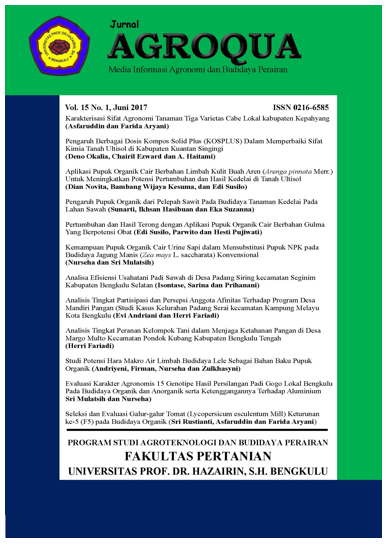PENGARUH MIKORIZA, PGPR DAN PUPUK UNTUK MENINGKATKAN PRODUKSI KEDELAI HITAM
DOI:
https://doi.org/10.32663/ja.v17i2.1040Keywords:
Black Soybean, Mycorrhizae, PGPRAbstract
Mycorrhizae and PGPR (Plant Growt Promoting Rhizobacteria) are widely published in scientific research can increase crop production by optimizing nutrient uptake, but studies rarely combine PGPR bacterial groups with mycorrhizae in one application on one plant. Mycorrhizal fungi can help plants absorb phosphorus and water absorption while PGPR can provide nitrogen for host plants. The general objective of this research is to find an effective combination of mycorrhizae, PGPR and Fertilizers. While the specific purpose of this study is to look for the influence of mycorrhizae, PGPR and fertilizer in increasing the production of black soybean plants. The results showed that mycorrhizal and PGPR treatment had not been able to increase nutrient uptake of nitrogen and phosphorus so that the parameters of increased production such as the number of pods, pod weight, seed weight and weight of 100 black soybean seeds were not significantly different. Mycorrhizal, PGPR and fertilizer treatments were not significantly different, treatment between mycorrhizal, PGPR and fertilizer negatively influenced each other, mycorrhiza experienced competition between fungi in the soil, as well as PGPR experienced competition with other microbials that were in the soil or competition between mycorrhizae and PGPR. An effective treatment in increasing the production of black soybean plants is mycorrhiza without PGPR and added 25% fertilizer.
Downloads
Published
Issue
Section
License
Authors who publish with this journal agree to the following terms:
- Authors grant the journal right of first publication with the work simultaneously licensed under a Creative Commons Attribution 4.0 Internasional (CC BY 4.0) Licence that allows others to use and share the work with an acknowledgment of the work's authorship and initial publication in this journal.
- The author(s) still hold the copyright of his/her/their work and retain publishing rights without restrictions such as (but not limited to) patent right, lecture, book and reproduce the article for own purposes.
















